SH Ashore 2

Beez Neez now Chy Whella
Big Bear and Pepe Millard
Wed 12 Feb 2020 23:57
|
St Helena Ashore for the Second Time –
Wednesday 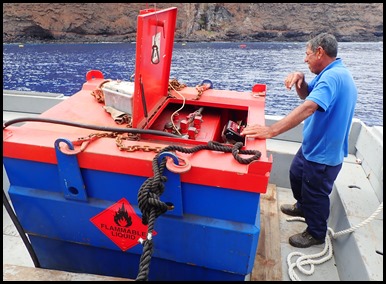  Smiling diesel delivery
men appeared at eight thirty.
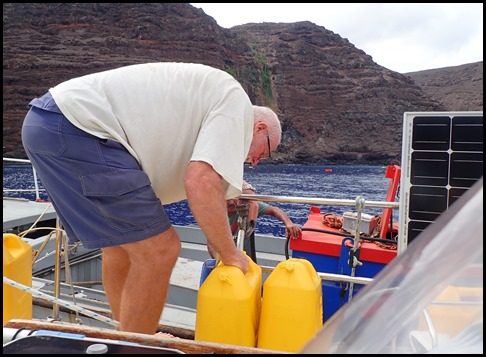 Bear swung into
action.
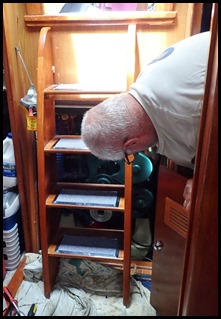   After the diesel had been sorted, Bear set
about the pesky alternator problem. I busied myself
assembling Bear’s muesli fruit for the longest
journey we have undertaken (three thousand, nine hundred miles, from St Helena
to Jolly Harbour, Antigua) – this time only tined fruit as fresh is in thin
supply in the supermarkets. Then the job my teeth do backstroke just thinking
about, wrist deep in sticky, dried fruit, chopped and mixed
with his packets of muesli. The last time I’ll do this before we ‘Close
the Circle’ on this epic trip of ours.
 Looking at this peaceful scene you would
not believe we can roll like snot. Quite unpleasant in
fact.....
 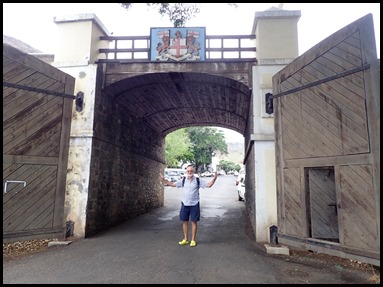 Ashore, instead of cutting through The
Garden, we bimbled a little further so we could take in the town’s Main Gate.
  On the other side of
the gate we saw the date of 1832 along with a mark noting the level of the flood of the 14th of April 1878. The biggest
flood occurred five years before. On the 20th of February 1873 at eight
o’clock in the morning a cloudburst over Sandy Bay Ridge led to consequent
floods at Sandy Bay, Friar’s Valley and Jamestown. It was a terrifying
experience for the residents on both sides of the island, with the force hitting
Jamestown, Sandy Bay and Friar’s Valley in the early morning. In Sandy Bay two
children lost their lives and there was much damage to about 160 metres
of walls and cultivated ground. There
The valley sides are an average of 533
metres in height and although Jamestown looks flat there is a drop of a hundred
metres to sea level. The water flowed from the ridges down the two main valleys,
joining together above Bishop’s Bridge. There was damage to the footbridge above
Maldavia Gardens where the old road led up this side of the valley before
crossing and winding up Side Path and the Briars. The piped water supply to town
from Chubbs Spring was damaged and the narrowing of watercourse above New Bridge
further concentrated the force of the water and the debris. New Bridge was
washed away by the floodwaters.
Next water came flooding down Market
Street and the Back Way, bursting through any buildings in its way. Some water
ran down towards Main Street, the remainder down Narrowbacks. Nearly all the
houses on the left of the street were flooded and water hit them from both sides
until dissipating below what is now the DIY Store – this was Jackson’s
Dispensary. This property was hit from both sides.
A woman was washed out to sea but it
thought that her “voluminous skirts” saved her. Three donkeys were also washed
out to sea and they too were rescued. Unbelievable as we stand and look at
Main Street today.
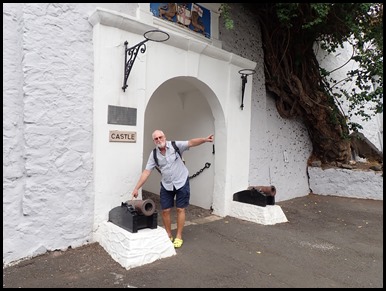 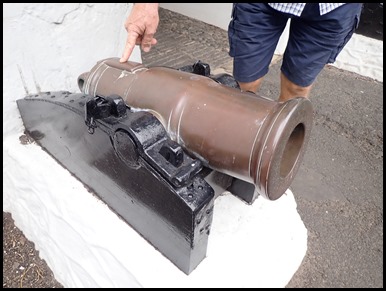 Beyond the gate, to the left, The Castle with the cutest
canon.
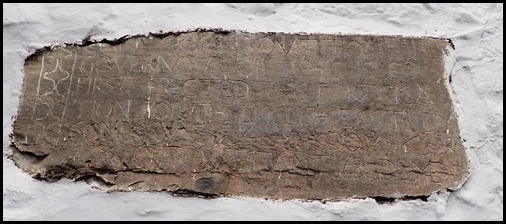  The old stone has a newer one below that is easier to
read.
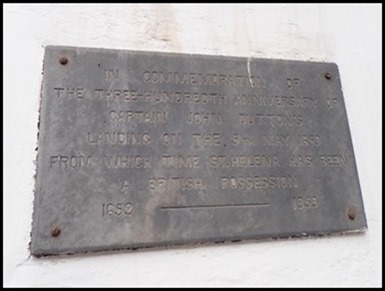  The plaque
reads: In commemoration of the three-hundredth anniversary of Captain
John Dutton’s landing on the 5th May 1659 from which time St. Helena has been a
British possession. 1659 - 1959. The castle
courtyard.
 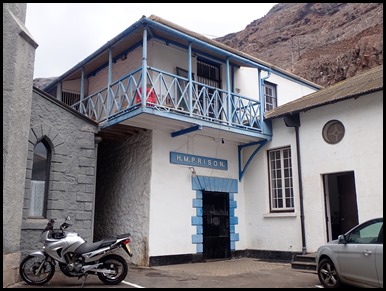 We crossed over and passed the bottom of Jacob’s Ladder and in the far corner a tiny prison.
 St James’
Church dominates this end of town. History of St
James taken from the church pamphlet: It is believed that since the
arrival of the first sailors during the 1500’s, there has been a chapel or
church on or near this site in James’ Valley; indeed, the valley was first
called “Chapel Valley”. In his report of the island, written in 1588 Cavendish
wrote ....we found a marvellous fair and pleasant valley, wherein lay
divers handsome buildings and houses were set up, and especially one which was a
church, which was tiled and whitened on the outside very fair, and made with a
porch..... His account gives more details and
gives the date to the cross erected outside the church, that of
1571.
The first Anglican church in Jamestown
was built following the arrival of the East India Company in 1659 and their
first chaplain in 1671. It is thought not to have been a very solidly built
church as by 1678 it was in need of repair. Many petitions were made to the
Governor in Council before any action was taken and it was 1772 before
preparations were made to build a new church. The church built in 1774 still
stands although it has been altered during its life. You will see inside, marks
on the walls, suggesting the roof height has been raised and that there was also
a gallery in the church at some time.
The North tower originally stood at
the West end of the church but it was found to be in a dangerous condition in
the 1830’s. A bulge appeared in one wall and the tower was demolished in 1835. A
new tower and porch was built by the North door and a spire added in 1843. The
total cost of this work was one thousand, three hundred pounds..... In 1843 the
tower had to be dismantled as it was unsafe, a new tower was built by the north
door with a spire. In 1849 St James was handed from the East India Company to
the church to maintain. In 1859 the diocese of St Helena was created and the
first Bishop of St Helena arrived. The spire became unsafe and was taken down in
1980. The spire was constructed from
porous red stone mined in James’ Valley and held together with iron ties. The
ties rusted and in 1980 the spire had become dangerous and was taken down. A
memorial to the workforce is on the west wall of the porch. In the 1900’s the
roof was replaced twice – once in 1902 when the slates were replaced by
corrugated iron at a cost of four hundred pounds. An asbestos roof followed this
and now there is an iron roof installed by Mr Barry Henry and his team in the
early 1900’s.
The church is large – it served the
garrison of the town and several pews are marked “military”. The tower was
originally at the West End and there was no north porch. . Thirty years later
restoration work began and the spire was replaced in 2016. Restored a few
years ago the clock is wound every week.
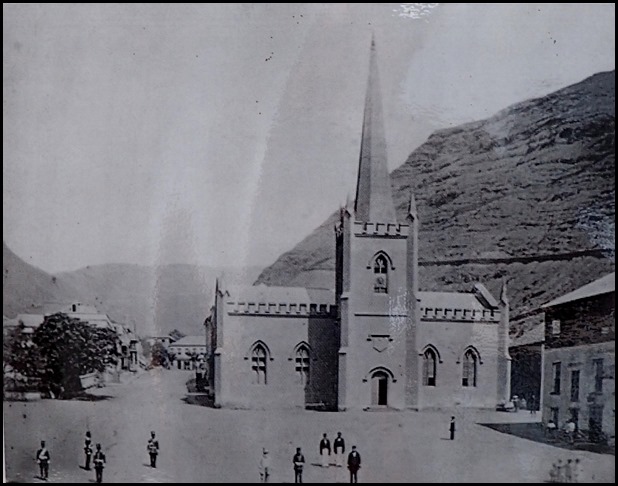 In the porch was a
picture of the church taken in the 1860’s.
 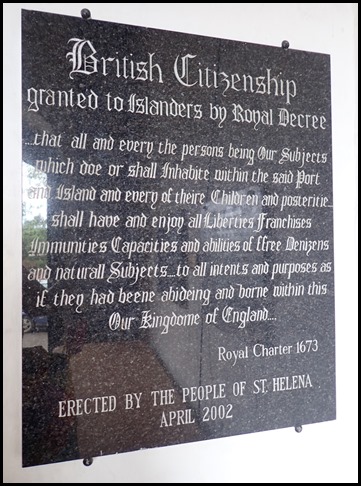 Plaques in the
porch.
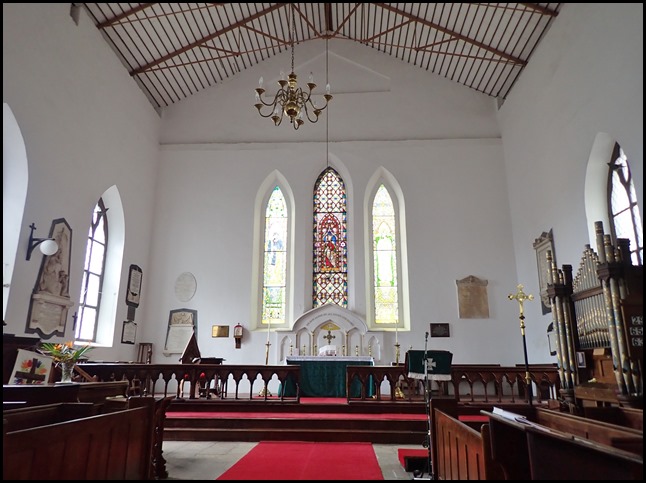 Inside the large
church – the oldest Anglican church south of the Equator. The central
stained glass window depicts The Good Shepherd which was installed in 1874. Each
side are two painted glass windows of St James and St John. The teak altar rail
was presented in memory of Thomas Ford Thompson, a long-serving parish clerk and
schoolmaster. In the 1800’s St James’ Church suffered the attentions of the
white ants. In 1862 it had to be closed to public worship. You will notice that
all the furniture is made from hardwoods like iroko and teak.
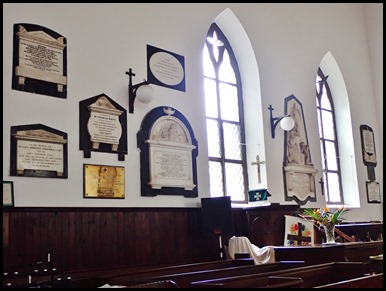  To the left on the wall are some interesting marbles and brasses, the stories of
soldiers and East India Company employees is told in these memorials. They tell
of deaths as travellers to England from India stopped to recover from what
proved to be fatal illnesses. A local memorial reads: In
Memory of George Singer who met his death by being accidentally precipitated
from Egg Island, when faithfully serving his employees. By whom this tablet is
erected as a mark of respect to a worthy good servant. To the right stands
the organ.
 Entry number nine belongs to Napoleon Bonaparte in the Register of Burials.
 Settle in Anne’s Place, this time joined by
Wendy and Jim (Jaga II) we loved a recipe tea
towel hung on the wall.
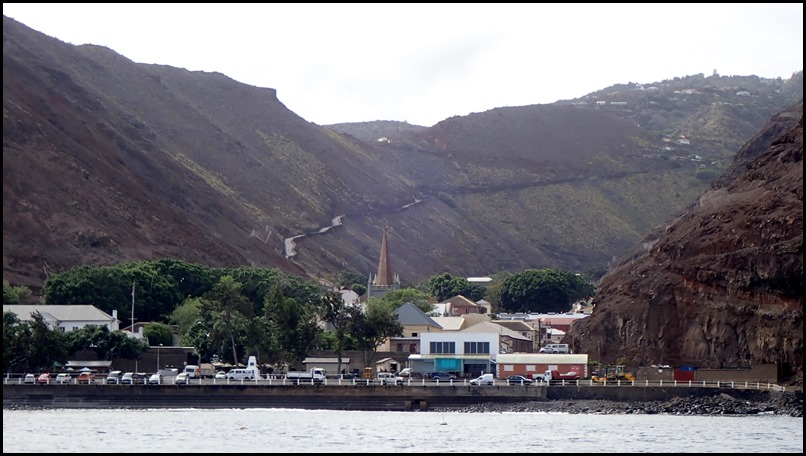 On the ferry back this
afternoon it is hard to picture water coursing down to the sea in
1878.
ALL IN ALL THE ISLAND HISTORY IS
FASCINATING
VERY PICTURESQUE OLDE WORLD
TOWN
|